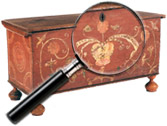|
|
Evan Griffith Ricketts (1785 to 1874)
Evan Griffith Ricketts (1785-1874) was born in Cecil County, Maryland, and married Hannah Travers in that state on May 28, 1812. The couple immediately moved west, settling in Maysville, Kentucky, by February 8, 1813, when their first child was born. Evan G. Ricketts is listed as a potter in the 1850 census (the first census to list occupations) and clearly began manufacturing stoneware before making this pitcher in [...] Click here to continue reading.
Ballard Family Potteries
In 1854 the three Ballard brothers of Burlington, Vermont, Orrin L, Alfred K, and Hiram N. took over the old Thompson & Co. pottery in Gardiner, Maine. They operated the Gardiner facility for about a year and produced wares with the incised mark BALLARD & BROTHERS/GARDINER ME.
Following this experience, Orrin and Alfred moved to Portland, Maine, where in 1855 they established a pottery at 100 Green Street. The 1856 [...] Click here to continue reading.
John Needles
John Needles (1786-1878) opened a cabinet shop on Hanover Street in Baltimore in 1810. He was active until 1853.
Some pieces are stenciled J. NEEDLES.
Circa 1835 to 1853, he is believed to have used the stencil John Needles / Cabinet Maker / 54 Hanover St. / BALTo.
Paper labels can also be found. One printed label reads, JOHN NEEDLES, / MANUFACTURER OF / Cabinet Furniture, / 54 Hanover STREET, [...] Click here to continue reading.
Charles & Ernest Schneider Glass & Lamps 1913 to 1937 and 1950 to 1981
Charles Schneider was born near Paris, France in 1881. He was originally a freelance designer for Daum from 1901 to 1911. In 1913, Charles and his brother Ernest officially opened their own glass works called Schneider Freres & Wolf, which closed during part of the war and reopened as “Societe Anonyme des Verreries Schneider in 1917. In 1925, theirs was [...] Click here to continue reading.
Edwin Lord Weeks Art in the Collection of Bernard Broder
Ellen K. Morris, PhD, who is currently preparing a catalogue raisonne of the artist writes about the Broder collection as follows:
Comparatively little is known or understood of Edwin Lord Weeks’ earliest works. In part, this must be because many of them fall outside the context of the works for which the artist is primarily known – finely rendered works recording his travels in [...] Click here to continue reading.
Shona-Hah or Mary J. Smith (Native American, 1912 to 1997)
Shona-Hah or Mary J. Smith was Cherokee by birth and became the matriarch of the Lelooska family. Her artwork, and especially her “Little People,” has left a legacy of both the everyday activities and the ceremonial dress of Native Americans. In June 1983 Southwest Art featured her in an article on pages 65-71.
Information courtesy of Cowan’s Auctions Inc., September 2006.
Trinity House Boxes
Trinity House was the name for the lighthouse service in Great Britain in the 19th century. While on station, the keepers of lighthouses and lightships made exceptional boxes with fancy wood inlays, including marquetry and parquetry, often featuring sloops, lighthouses and other nautical symbols of the period. Sizes typically fall in the 6- to 12-inch range. The keepers sold these boxes directly to the captains of sailing vessels using Trinity House [...] Click here to continue reading.
Isaac Augustus Wetherbee, 19th Century Portrait Painter & Photographer
Isaac Augustus Wetherbee (also spelled Wetherby) was born in Providence, Rhode Island on December 6th, 1819 to Isaac Wetherbee and Sophia Greene. He was painting in the Norfolk County / Boston area in the late 1830′s and 1840′s. The 1842 Boston City Directory lists him as a portrait painter and he is thought to have been one of the earliest Daguerreotype photographers. According to the [...] Click here to continue reading.
Ferdinand A. Brader (1833-?)
An untrained, itinerant artist, known for his large, detailed, birdseye view, pencil drawings of farms and other dwellings, Ferdinand A. Brader was born in Switzerland in 1833. He migrated to the United States and Pennsylvania in the early 1870s.
Most of his drawings are quite large, some measuring 50″ by 36″, and were done using graphite pencil. In 1893 he began incorporating colored pencil into his pictures. Most of [...] Click here to continue reading.
Flax
Flax, also known as linseed, (binomial name: Linum usitatissimum, a member of the genus Linum in the family Linaceae), is an ancient and versatile plant of many uses. Dyed flax fibers have been found dating to 30,000 B.C., suggesting that it may have been the first plant domesticated for human use. In addition to its fibers, flax seeds have nutritional value for both human and animal consumption. From the earliest times these seeds [...] Click here to continue reading.
|
Recent Articles
- Charles Alfred Meurer – American Artist & Tromp L’Oeil Artist
- Sendak, Maurice – American Artist & Writer
- Godie, Lee – American Artist
- Davis, Vestie – American Artist
- Bartlett, Morton – American Artist
- Mackintosh, Dwight – American Artist
- Evans, Minnie Jones – African-American Artist
- Mumma, Ed (Mr. Eddy) – American Artist
- Nice, Don – American Artist
- Savitsky, John (Jack) – American Artist
- Gordon, Harold Theodore (Ted) – American Artist
- Dial, Thornton – African-American Artist
- Doyle Sam – American Artist
- Johnson, Lester Frederick – American Artist
- Finster, Howard – American Artist
|
|
